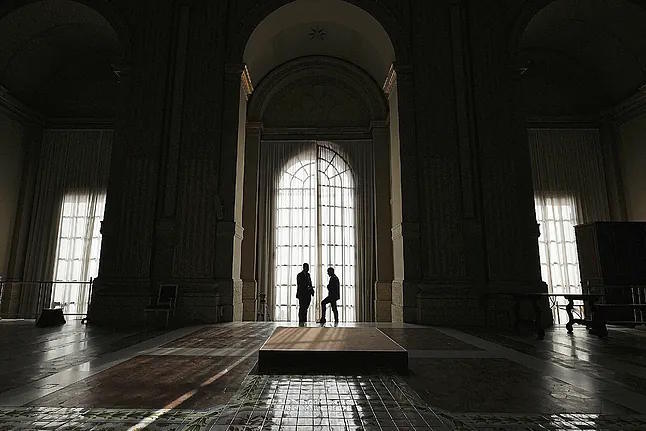This time it will not be enough to lock the cardinals in the Sistine Chapel "cum clave" ("under key"). Nor will it be sufficient with the oath in the Pauline Chapel in which all individuals with direct or indirect access to the cardinals participated on Monday. The 650 surveillance cameras and the imposing physical presence of the agents of the Vatican City Gendarmerie and the Pontifical Swiss Guard, heavily armed, will contribute in their own way to project the sensation of total lockdown.
But the main novelty in this conclave is the cybersecurity and digital shielding to prevent contact, interference, or intrusion from the outside world. The 21st-century conclaves have faced increasing technological challenges, although none like this, amidst advances in artificial intelligence, drones, satellites, cyber-attacks, misinformation, and the siege of social networks.
The Vatican authorities have a dual mission: to ensure the safety of the cardinals participating in the conclave and at the same time safeguard the strict secrecy of the process (under penalty of excommunication) until the election of the new Pontiff, announced with the traditional white smoke.
Since 2005, when Joseph Ratzinger was elected as Benedict XVI, the use of mobile phones has been prohibited during the process. The cardinals will be required to surrender them at the beginning of the conclave and will not be able to retrieve them until the end, along with their computers and tablets.
And if anyone were to have a hidden or spare device, any attempt to send or receive messages will be futile, thanks to the frequency inhibitors installed around the conclave perimeter to create communication interferences. The surveillance staff will check the cardinals twice before the votes to ensure they are not carrying any electronic devices.
The spokesperson for the Holy See, Matteo Bruni, announced that starting at three o'clock on Wednesday, all mobile phone transmission systems will be deactivated within the Vatican. "The signal will be restored when the election of the new pontiff is announced," Bruni warned. However, mobile phones will continue to work outside the Vatican walls, in the colonnades of St. Peter's Square.
Special opaque anti-drone and anti-laser films have been temporarily installed on the windows of the Sistine Chapel. Vatican technicians have subjected the temple decorated by Michelangelo to a brief inspection to ensure its total physical and virtual isolation. The goal is to turn it into a true digital bunker.
Even the personnel attending to the cardinals must swear to refrain from "using any means of recording, listening, or viewing anything that takes place in the Vatican City during the electoral period and, in particular, anything directly or indirectly related to the operations connected with the election itself."
The Vatican Gendarmerie has launched a cybersecurity plan, centralized from the Vatican Apostolic Library, as reported by Il Corriere della Sera. All communications between the dicasteries have been encrypted. A new radio system - also encrypted - has been implemented for use in high-risk situations.
Between 2022 and 2024, the Vatican has suffered several attacks by hackers. Some of them, with direct interference on the Holy See's portal, coincided with Pope Francis' statements during the Ukraine war and during the visit of Olena Zelenska to the Vatican. It is suspected that the attacks may have originated from Russia.
Despite the reinforcement of cybersecurity, a report from Il Tempo revealed at the end of last year that 90% of the Vatican portals could be classified as "not secure." The Holy See has hired the services of companies such as the British Cip and the Israeli Radure and has requested the intervention of the Italian National Cybersecurity Agency.
Luis Antonio Tagle, the 'progressive' and 'rockstar' cardinal
Jean-Marc Aveline, the 'Zidane' of the conclave with Almerian blood
According to Wired magazine, the Vatican has been able to resort to artificial intelligence to ensure the secrecy of the conclave. One possibility could be that the surveillance cameras incorporate AI systems capable of "understanding" what they see and detecting unusual patterns that could compromise the integrity of the process.
The closure of doors and windows remains in any case the most basic and effective measure. "Nevertheless, the cardinals are not hermetically isolated and have daily contact with people from the outside world," recalls Stephen Bullivant, professor of Theology at St. Mary's University in Twickenham, referring to scenes from the movie Conclave, where cardinals can be seen socializing in the dining room or interacting with the staff of the Casa Santa Marta where they are housed.
The short kilometer between their dormitories and the Sistine Chapel will be covered daily by bus, within the Vatican walls, which despite being the smallest country in the world (0.44 square kilometers) is also one of the most monitored, with those 650 cameras monitoring its streets and connected to an underground control center.
"I promise and swear absolute secrecy"
"I promise and swear to observe absolute secrecy (...) regarding everything directly related to the voting and scrutiny for the election of the Supreme Pontiff"... The doctors and nurses assisting the cardinals, the technicians ensuring the secrecy of the process, the colonel and a major of the Pontifical Swiss Guard, the nuns preparing and serving food at Santa Marta, the cleaning staff, and even the florist personnel joined the collective oath celebrated on Monday afternoon in the Pauline Chapel and officiated by the Camerlengo, Kevin Joseph Farrell. The act traditionally marks the countdown, about 48 hours, to the proclamation of "Extra Omnes" ("Everyone Out"), which will mark the beginning of the conclave on Wednesday afternoon, when the first vote will take place.
